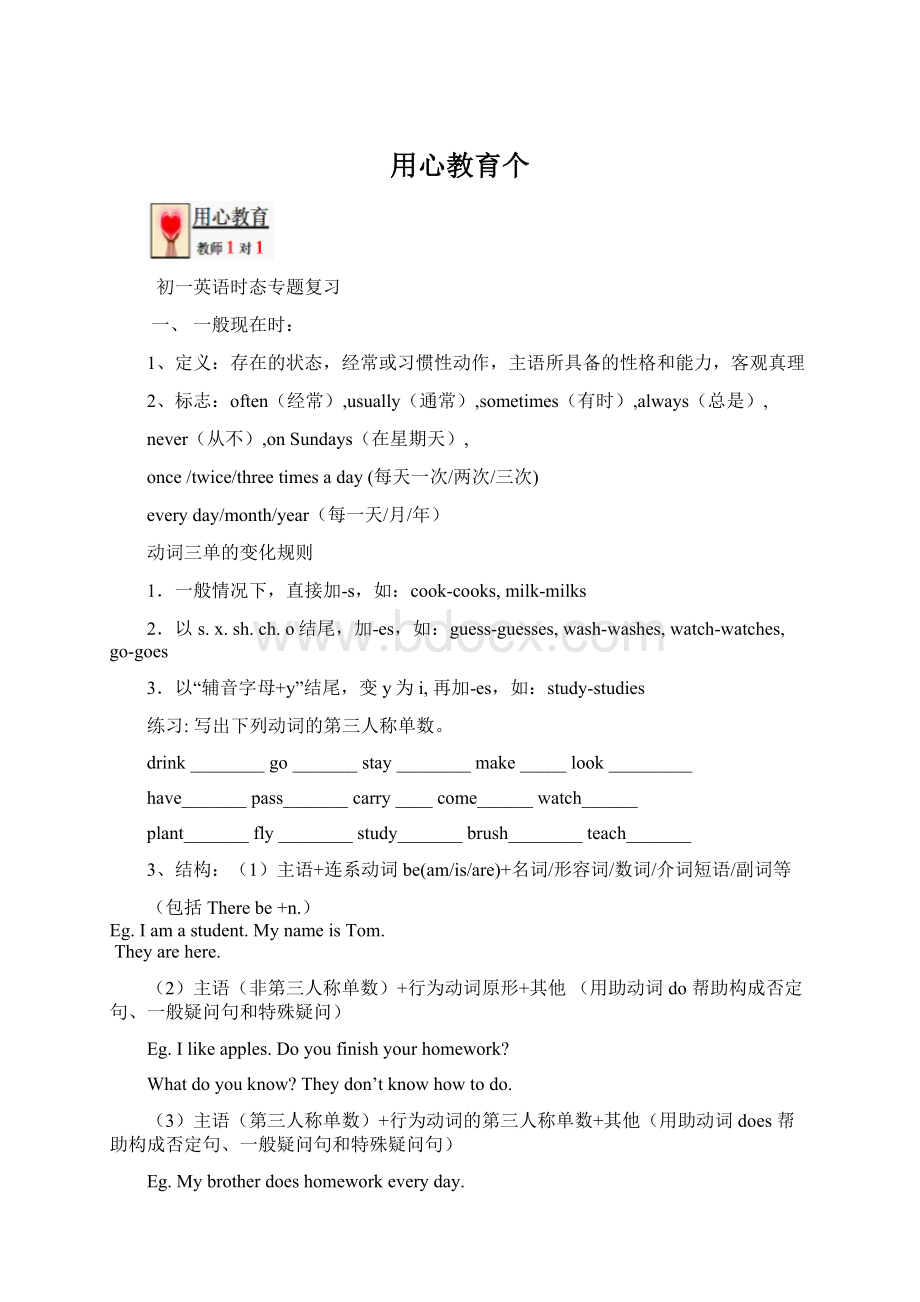用心教育个.docx
《用心教育个.docx》由会员分享,可在线阅读,更多相关《用心教育个.docx(11页珍藏版)》请在冰豆网上搜索。

用心教育个
初一英语时态专题复习
一、一般现在时:
1、定义:
存在的状态,经常或习惯性动作,主语所具备的性格和能力,客观真理
2、标志:
often(经常),usually(通常),sometimes(有时),always(总是),
never(从不),onSundays(在星期天),
once/twice/threetimesaday(每天一次/两次/三次)
everyday/month/year(每一天/月/年)
动词三单的变化规则
1.一般情况下,直接加-s,如:
cook-cooks,milk-milks
2.以s.x.sh.ch.o结尾,加-es,如:
guess-guesses,wash-washes,watch-watches,go-goes
3.以“辅音字母+y”结尾,变y为i,再加-es,如:
study-studies
练习:
写出下列动词的第三人称单数。
drink________go_______stay________make_____look_________
have_______pass_______carry____come______watch______
plant_______fly________study_______brush________teach_______
3、结构:
(1)主语+连系动词be(am/is/are)+名词/形容词/数词/介词短语/副词等
(包括Therebe+n.)
Eg.Iamastudent.MynameisTom.
Theyarehere.
(2)主语(非第三人称单数)+行为动词原形+其他(用助动词do帮助构成否定句、一般疑问句和特殊疑问)
Eg.Ilikeapples.Doyoufinishyourhomework?
Whatdoyouknow?
Theydon’tknowhowtodo.
(3)主语(第三人称单数)+行为动词的第三人称单数+其他(用助动词does帮助构成否定句、一般疑问句和特殊疑问句)
Eg.Mybrotherdoeshomeworkeveryday.
Whendoeshegotoschool?
Dosesheborrowyourbook?
练习:
一、填空。
1.Heoften (have)dinnerathome.
2.DanielandTommy (be)inClassOne.
3.We (notwatch)TVonMonday.
4. yourparents (read)newspaperseveryday?
5.There (be)somewaterinthebottle.
6.There (be)littlewaterinthebottle.
7.Mike (like)cooking.
8.Theearth (go)aroundthesun.
9.ThemanwhohasneverbeentotheGreatWall (be)notarealman.
二、按照要求改写句子。
1.DanielwatchesTVeveryevening.(改为否定句)___________________________________________________
2.Idomyhomeworkeveryday.(改为一般疑问句,作否定回答)________________________________________________________
3.Shelikesmilk.(改为一般疑问句,作肯定回答)___________________________
4.Amylikesplayingcomputergames.(改为一般疑问句,作否定回答)___________________________________________________
5.Wegotoschooleverymorning.(改为否定句)_______________________________________________________
6.HespeaksEnglishverywell.(改为否定句)___________________________________________________
7.Iliketakingphotosinthepark.(对划线部分提问)________________________________________________________
8.JohncomesfromCanada.(对划线部分提问)___________________________________________________
9.Sheisalwaysagoodstudent.(改为一般疑问句,作否定回答)________________________________________________________
10.SimonandDaniellikegoingskating.(改为否定句)___________________________________________________
三、改错(划出错误的地方,将正确的写在横线上)
1.IsyourbrotherspeakEnglish?
__________________
2.Doeshelikesgoingfishing?
__________________
3.Helikesplaygamesafterclass.__________________
4.Mr.WuteachsusEnglish.__________________
5.Shedon’tdoherhomeworkonSundays._________________
二.现在进行时
1、定义:
表示说话瞬间或现阶段正在进行的动作。
2、结构:
主语+助动词be(am/is/are)+v-doing
动词加ing的变化规则
1.一般情况下,直接加ing,如:
cook-cooking
2.以不发音的e结尾,去e加ing,如:
make-making,taste-tasting
3.如果末尾是一个元音字母和一个辅音字母,双写末尾的辅音字母,再加ing,如:
run-running,stop-stopping
现在进行时专项练习:
一、写出下列动词的现在分词:
play________run__________swim_________make__________go_________
like________write________ski___________read________have_________
sing________dance_________put_________see________
love_________live_______take_________come________get_________
stop_________sit________begin________shop___________
3、用法:
1)表示说话人说话时正在进行的动作,不涉及该动作的发生与结果,常与
now,atthistime,atpresent,atthemoment等时间状语连用。
还
有当look,listen在句首时,也用现在进行时
Eg.Jimistakingphotosintheparknow.
Look,thatchildisclimbingthetree.
2)表示某个按最近的计划或安排将要进行的动作,或即将开始或进行的动作。
常用是表位置转移动词move,return,arrive,meet,stop,dogo,come,leave,stay,start,land,等,通常要与表示将来的时间状语来连用
Eg.Heiscomingtoseeyousoon.
They’releavingforBeijingtomorrow.
练习:
1.Listen!
She____(sing)intheclassroom.
2.I____(wash)theclothesatpresent.
3.Theplane____(arrive)tomorrow.
4.Look!
Lucyis_____(ride)anewbiketoday.
5.Look.They_______________(have)anEnglishlesson.
6.They____________(not,water)theflowersnow.
7.Look!
thegirls________________(dance)intheclassroom.
8.Whatisourgranddaughterdoing?
She_________(listen)tomusic.
9.It’s5o’clocknow.We_____________(have)suppernow10.______Helen____________(wash)clothes?
Yes,sh
三、一般现在时与现在进行时的比较
(1)一般现在时通常表示经常性的动作或状态,而进行时则表示在某一时刻或某段时间
正在进行的动作。
Wereadnewspaperseveryday.我们每天读报。
(说明习惯)
Sheisnowreadingthenewspaper.她现在正在读报。
(强调现阶段)
Thebusisstopping.汽车渐渐停下来。
Thebusstops.迅速停车。
(2)一般现在时表示主语的固有特征、能力等,而进行时态则表示主语在某一时刻或某
段时间内所进行的具体动作。
Hesingswell.他唱得很好。
Heissingingasong.他正在唱一首歌。
HelivesinLiangxiang.他家住良乡。
(永久性)
HeislivinginLiangxiang.他现在住在良乡。
(一段时间居住)
(3)现在进行时带有感情色彩而一般现在时表示客观事实
Janeisdoingfineworkatcollege.简在大学学习很好。
(赞扬)
Janedoesfineworkatcollege.简在大学学习很好。
(事实)
(4)通常只能用一般现在时而不用进行时的动词并非所有的动词都有进行时,如表状态、感情、感觉的动词,通常只能用一般现在时而不用进行时,因为这些动词不能表示一个正在进行的动作,如know,love,hate,want,like,see,hear,taste,smell,have(有),be等。
Thefoodtastesdelicious!
饭很香!
(正)
Thefoodistastingdelicious.(误)
IlikeEnglishverymuch.我喜欢学英语。
(正)
IamlikingEnglishverymuch.(误)
1.Heusually___________upat17:
00.(get)
2.She___________(live)inBeijing.
3.Theyare__________(dig)ahole(洞).
4.Myfather_______________(mend)hismodel(模型)planethesedays.
5.It’ssixo’clock.Theyare_____________supper.(eat)
6.She______________(go)toschoolateighto’clock.
7.He_________(notlike)vegetable.Buthe__________(eat)thecabbagenow.
四、一般将来时
1、构成:
由“助动词will/shall+动词原形”构成。
will用于第二、三人称,shall第一称。
2、用法:
1)表示未来的动作或存在状态,常与表示将来的时间状语连用,如tomorrow,nextSunday,soon,inamonth/twodays/threeyears,inthefuture等。
Eg.WeshallleaveforLondonnextMonday.
Hewillcometoseeyouthedayaftertomorrow.
Youwillbe20nextyear.
2)表示将来反复发生的动作或习惯性动作
Eg.Weshallcomeandworkinthisfactoryeveryyear.
ThestudentswillhavefiveEnglishclassesperweekthisterm.
3、其他表达法
1)“begoingto+动词原形”表将来
①这种结构表示打算、计划、决定要做的事或肯定要发生的事。
WhatareyougoingtodonextSunday?
②还可表示说话人根据已有的事实或迹象,认为某事即将发生、肯定会发生或可能出现的情况。
IthinkI'mgoingtodie.
Lookatthecloud.It’sgoingtorain.
③这种结构表示“肯定、预测,注定会”。
在这种情况下可以和“think,hope,want,believe,like”等表示静态的动词连用。
Thequestionisgoingtobeverycomplex.这个问题将会很复杂。
2)用现在进行时来表示将来
3)“beaboutto+动词原形”表将来
表示打算或据安排即将发生的动作。
它不与表示时间的副词或其他时间状语连用。
TheEnglisheveningisabouttostart.
▲beaboutto意为“正要、马上就”;benotaboutto意为“不愿意……”。
4)“beto+动词原形”表将来
表示约定的、计划中的或按职责、义务要求要发生的动作,这种动作通常是人的意
志所能控制的,或用于征求意见。
Youaretohandinyourpapersby10o'clock.到10点你得交上试卷。
Ifamanistosucceed,hemustworkashardashecan.
4、begoingto和will的区别
①will表示说话人认为、相信、希望或假定要发生的事,不含任何具体的时间,可以指遥
远的将来;而begoingto指有迹象表明某事即将发生或肯定发生,通常指很快就要发生
的事情。
Listentothewind.Wearegoingtohavearoughcrossing.
Shewillnotshovetheheavyloadontoothers.
Hewillgetbetter.他的病会好的。
(即认为最终会恢复健康,而不是马上恢复)
Heisgongtogetbetter.他的病就会好了。
(指有恢复的迹象)
②begongto和will均可表示意图,但事先考虑过的意图用begoingto,不是事先考虑
过的意图用will。
-Whyhaveyoutornthepaperintopieces?
-Iamgoingtorewriteit.(事先考虑,不用will)我要重写。
-Isitreallyabigstone?
-Iwillhelpyoutomoveit.(未经事先考虑,不用begoingto)
③begoingto可以用在条件状语从句中表示将来,而will不能。
Ifyouaregoingtoattendthemeeting,you’dbetterleavenow.
练习:
1.There__________ameetingtomorrowafternoon.
A.willbegoingtoB.willgoingtobe
C.isgoingtobeD.willgotobe
2.Charlie________herenextmonth.
A.isn’tworkingB.doesn’tworking
C.isn’tgoingtoworkingD.won’twork
3.He________verybusythisweek,he________freenextweek.
A.willbe;isB.is;is
C.willbe;willbeD.is;willbe
4.There________adolphinshowinthezootomorrowevening.
A.wasB.isgoingtohave
C.willhaveD.isgoingtobe
5.–________you________freetomorrow?
–No.I________freethedayaftertomorrow.
A.Are;goingto;willB.Are;goingtobe;will
C.Are;goingto;willbeD.Are;goingtobe;willbe
5、一般过去时
1.一般过去时表示过去某个时间发生的动作或存在的状态,常和表示过去的时间状语连用。
一般过去时也表示过去经常或反复发生的动作感谢。
2.Be动词在一般过去时中的变化:
?
am和is在一般过去时中变为was。
(wasnot=wasn’t)
?
are在一般过去时中变为were。
(werenot=weren’t)
?
带有was或were的句子,其否定、疑问的变化和is,am,are一样,即否定句在was或were后加not,一般疑问句把was或were调到句首。
3.句中没有be动词的一般过去时的句子
否定句:
didn’t+动词原形,如:
Jimdidn’tgohomeyesterday.
一般疑问句:
在句首加did,句子中的动词过去式变回原形。
如:
DidJimgohomeyesterday?
特殊疑问句:
?
疑问词+did+主语+动词原形?
如:
WhatdidJimdoyesterday?
?
疑问词当主语时:
疑问词+动词过去式?
如:
Whowenttohomeyesterday?
构成:
由规则动词(-ed/-d)或不规则动词的过去时表示,除be外,其余动词没有人称和数的变化。
用法:
(1)表示过去某个特定时间发生的动作或存在的状态
常有明确的时间状语,如yesterday,lastnight,someyearsago,in1890等,以及由when等引导的时间状语从句。
Tomdidn'tcometoclassyesterday.
Wewenttodancelastnight.
(2)表示过去的习惯性或经常发生的动作常与often,usually,seldom等表示频度的副词连用。
WhenIwasinthecountryside,Ioftencalledonmyoldfriendsthere.IwenttothecinemaonceaweekwhenIwasatschool.
动词过去式变化规则:
1.一般在动词末尾加-ed,如:
pull-pulled,cook-cooked
2.结尾是e加d,如:
taste-tasted
3.末尾只有一个元音字母和一个辅音字母的重读闭音节,应双写末尾的辅音字母,再加-ed,如:
stop-stopped
4.以“辅音字母+y”结尾的,变y为i,再加-ed,如:
study-studied
5.不规则动词过去式:
am,is-was,are-were,do-did,see-saw,say-said,give-gave,get-got,go-went,come-came,have-had,eat-ate,take-took,run-ran,sing-sang,put-put,make-made,read-read,write-wrote,draw-drew,drink-drank,fly-flew,ride-rode,speak-spoke,sweep-swept,swim-swam,sit-sat
过去时练习:
写出下列动词的过去式
is\am_________fly_______plant________are________drink_________
play_______go________make________does_________dance________
worry________ask_____taste_________eat__________draw________
put______throw________kick_________pass_______do________
练习:
1.TomandMary___________(come)toChinalastmonth.
2.Mike_________________(notgo)tobeduntil12o’clocklastnight.SoI_______(get)uplate.
3.Mary__________(read)Englishyesterdaymorning.
4.There_________(be)noonehereamome